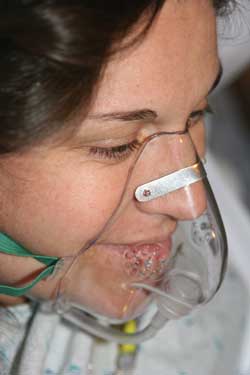To the Editor
 The recent letter to the editor by Drs. Stemp and Ramsay (Winter 2005-2006, page 80) sought to highlight how the administration of supplemental oxygen might mask the detection of hypoventilation. This occurs because when supplemental oxygen is administered (creating a higher fractional inspired concentration of oxygen) a greater degree of hypoventilation (on the order of 0.5–1 L/min) must take place prior to hypoxemia occurring. All good clinicians know, however, that oxygenation and ventilation should be monitored separately and by different means. Relying on, or even using, hypoxemia as detected by pulse oximetry to monitor and detect hypoventilation reminds me of the days when we used the EKG (or even a precordial stethoscope!) to detect hypoxemia by the onset of bradycardia. Anyone who remembers those days has an added appreciation of the value of pulse oximetry and the reduced stress levels it creates for patients and anesthesia providers alike. The fact that supplemental oxygen delays the onset of hypoxemia even if patients are hypoventilating should be taught and appreciated by all clinicians administering sedation or anesthesia. However, I disagree with the interpretation of this fact by Drs. Stemp and Ramsey. Indeed this is why supplemental oxygen should be given to most if not all patients undergoing sedation or anesthesia. Administering supplemental oxygen will lower the incidence and/or severity of hypoxemia even in the presence of hypoventilation, which is expected and common in patients undergoing sedation. Since it is hypoxemia and not hypercarbia that most often precipitates or is associated with severe negative outcomes in sedation settings, avoiding hypoxemia is imperative. I believe that allowing hypoxemia to occur or advocating that steps taken to reduce hypoxemia may be counterproductive, as Drs. Stemp and Ramsay argue, is misguided. Their contention at best recognizes that, all too often, some clinicians do resort to using pulse oximetry as the sole monitor of breathing. This practice should not, however, be condoned. Clinicians should always monitor minute ventilation by one or more means independently of oxygenation, and never rely on pulse oximetry as the monitor of ventilatory status. Various means can be used to assess ventilation independent of oxygenation and include assessments of the patient’s responsiveness, respiratory rate, rate and pattern of abdominal and thoracic excursion, the need for and effect of a gentle jaw thrust, and capnography, which is inexpensive and greatly underutilized in many sedation settings.
The recent letter to the editor by Drs. Stemp and Ramsay (Winter 2005-2006, page 80) sought to highlight how the administration of supplemental oxygen might mask the detection of hypoventilation. This occurs because when supplemental oxygen is administered (creating a higher fractional inspired concentration of oxygen) a greater degree of hypoventilation (on the order of 0.5–1 L/min) must take place prior to hypoxemia occurring. All good clinicians know, however, that oxygenation and ventilation should be monitored separately and by different means. Relying on, or even using, hypoxemia as detected by pulse oximetry to monitor and detect hypoventilation reminds me of the days when we used the EKG (or even a precordial stethoscope!) to detect hypoxemia by the onset of bradycardia. Anyone who remembers those days has an added appreciation of the value of pulse oximetry and the reduced stress levels it creates for patients and anesthesia providers alike. The fact that supplemental oxygen delays the onset of hypoxemia even if patients are hypoventilating should be taught and appreciated by all clinicians administering sedation or anesthesia. However, I disagree with the interpretation of this fact by Drs. Stemp and Ramsey. Indeed this is why supplemental oxygen should be given to most if not all patients undergoing sedation or anesthesia. Administering supplemental oxygen will lower the incidence and/or severity of hypoxemia even in the presence of hypoventilation, which is expected and common in patients undergoing sedation. Since it is hypoxemia and not hypercarbia that most often precipitates or is associated with severe negative outcomes in sedation settings, avoiding hypoxemia is imperative. I believe that allowing hypoxemia to occur or advocating that steps taken to reduce hypoxemia may be counterproductive, as Drs. Stemp and Ramsay argue, is misguided. Their contention at best recognizes that, all too often, some clinicians do resort to using pulse oximetry as the sole monitor of breathing. This practice should not, however, be condoned. Clinicians should always monitor minute ventilation by one or more means independently of oxygenation, and never rely on pulse oximetry as the monitor of ventilatory status. Various means can be used to assess ventilation independent of oxygenation and include assessments of the patient’s responsiveness, respiratory rate, rate and pattern of abdominal and thoracic excursion, the need for and effect of a gentle jaw thrust, and capnography, which is inexpensive and greatly underutilized in many sedation settings.
Peter Bailey, MD
Rochester, NY


 Issue PDF
Issue PDF